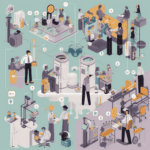
Fede: As automation and artificial intelligence transform the world of work, data-driven labor policies and workforce development strategies will be crucial in addressing the challenges and opportunities that arise from technological advancements.

Data and the Future of Work:
Automation and Labor Policy
Overview
Val, could you give us an overview of how automation and AI are shaping the future of work, and why data is essential in this process?
Val: Absolutely, Fede! Automation and AI are transforming the world of work by increasing efficiency and productivity, but they’re also posing challenges by displacing certain jobs and changing the skills required for others. Data is crucial for understanding these trends, as it helps us identify which jobs are most vulnerable to automation and which skills will be in demand in the future.
Alan: That’s right, Val. And this is where labor policy comes in. Governments and organizations need to use data-driven strategies to help workers adapt to these changes, whether that means supporting retraining programs, encouraging lifelong learning, or even rethinking social safety nets.
Examples
Fede: Thanks for that, Alan. So, what are some examples of data-driven labor policies that can help address the challenges posed by automation and AI?
Val: One example is using data to identify industries and regions most affected by automation, allowing policymakers to target resources and support more effectively. Another example is leveraging data to design and evaluate the effectiveness of workforce development programs, such as reskilling initiatives and vocational training.
Alan: And let’s not forget about the importance of collaboration between different stakeholders, like governments, employers, and educational institutions. By sharing data and insights, they can work together to create policies and programs that truly meet the needs of workers in a rapidly changing world.
Pitfalls
Fede: Great points, both of you. Now, what are some potential pitfalls or challenges that we should be aware of when using data to shape labor policies?
Alan: One potential pitfall is the risk of focusing too much on short-term trends, which could lead to reactive policies that don’t address the long-term challenges of automation and AI. It’s important to use data to inform a more strategic and forward-looking approach to labor policy.
Val: Additionally, we need to be mindful of potential biases in the data and ensure that policies and programs are inclusive and equitable, addressing the needs of all workers, regardless of their background or circumstances.
Closing
Fede: Thank you, Val and Alan, for sharing your insights on this important topic. In conclusion, as automation and AI continue to reshape the world of work, it’s essential to use data-driven strategies to create labor policies and workforce development programs that help workers adapt and thrive in the face of change.
If you have any thoughts on this subject or suggestions for future episodes, feel free to reach out to us at Datatunnel. Be sure to follow us on LinkedIn and X for more insights on data politics. Thanks for tuning in!
Resources
- The Layoff Generation: How Generative Ai Will Reshape Employment and Labor Markets by Qiwen Huang, Yifan Shen, Yuanchi Sun, Tony Zhang :: SSRN
- Gen-AI: Artificial Intelligence and the Future of Work (imf.org)
- Accenture Report Finds Perception Gap Between Workers and C-suite Around Work and Generative AI
- Generative AI’s impact on jobs and workflows | McKinsey
- AI and Its Implications for Political Decision-Making